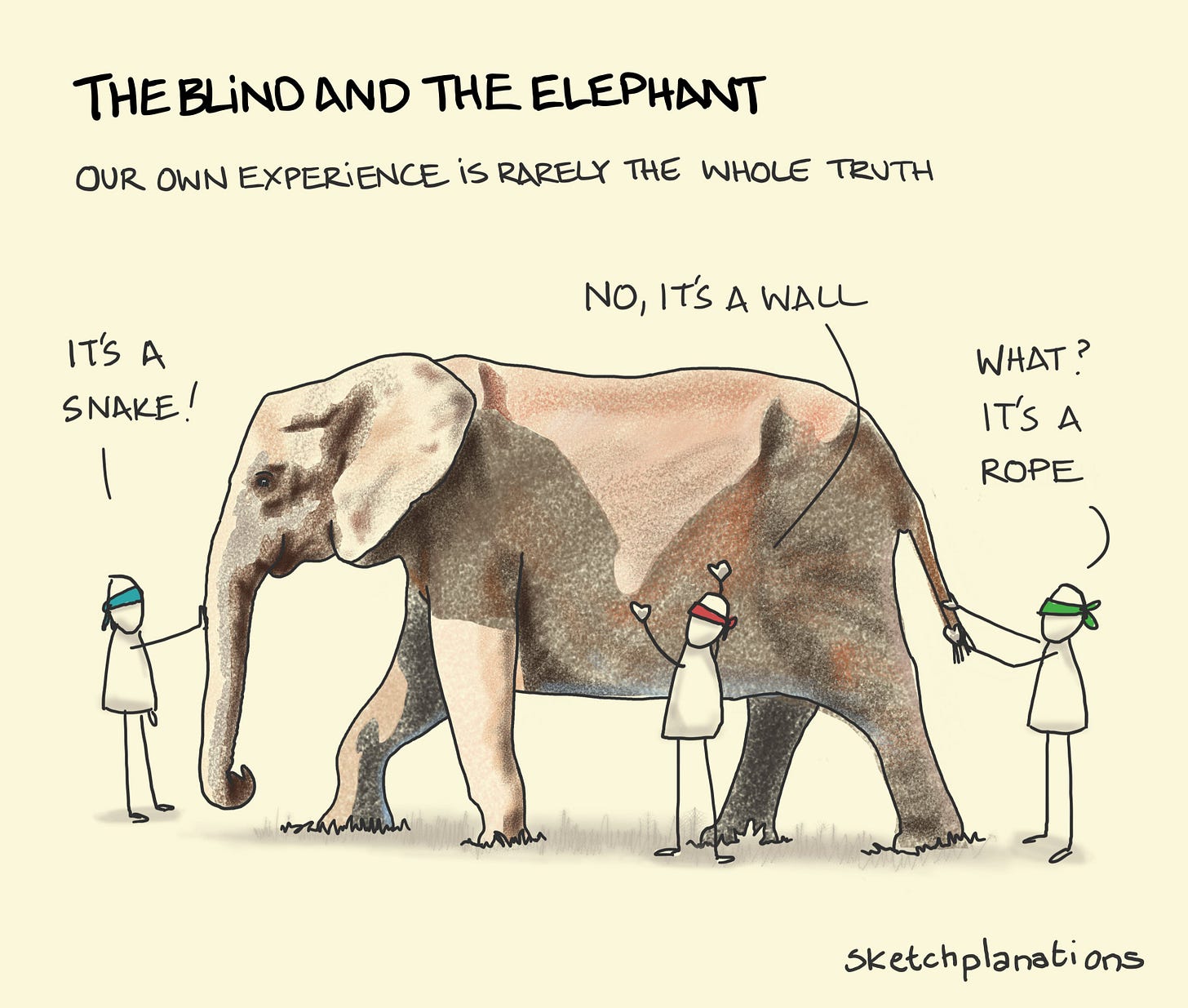A change in perspective is worth 80 IQ points
—Alan Kay
Take This 30-Second Quiz To Learn A Deep Life Lesson
I have a quick quiz for you that will tell you a lot about yourself. Here’s what to do it…
Look at the image below
Tell me the first three words you see in the comments
Look at other people’s comments on this post
Notice all the different responses
Hidden within this image is an even deeper message that cannot be seen with eyes…
In life, all of us are looking at the same reality, but we’re seeing completely different things.
Thought leaders find the most rare and valuable perspectives.
In other words, the image above is a microcosm of two things:
How reality works
The opportunity we have as thought leaders (more on this in the next section)
This is a big deal…
This Activity Illustrates How Creative Geniuses Come Up With Great Ideas
I am a believer that, at its heart, thought leadership is about concept marketing, not content marketing. To that end, the most fundamental thought leader skill is the ability to create rare and valuable ideas that change people’s lives and spread virally.
One great idea can change the trajectory of a thought leader’s career and a reader’s life. Trademark Ideas:
Crystallize people’s perceptions, thus helping them perceive something more clearly that was vague. For example, when you name different shades of red (i.e., maroon, crimson), you actually perceive colors in more detail. The same goes for any Trademark Idea.
Help people remember perceptions by giving them a simple, memorable word or phrase they can quickly reference.
Help new communities form. Once a word exists, people can search for it to find others interested in it. They’re no longer alone.
The question then is this…
The Big Question: How Do You Manufacture Life-Changing Ideas Consistently?
When I first asked myself this question, I was disappointed by the answers I found. While there are many resources on how to write better, how to be an entrepreneur, how to be more creative, and how to learn better, I found very few on how to actually create ideas better as a thought leader. It seemed like the creators of so many resources assumed that you already have an idea or that you can manufacture one out of thin air.
So, I began to study academic research on the topic and the processes of creative geniuses throughout history. Then, I applied what I learned to my own ideas.
To date, I’ve coined nearly 100 ideas that I’ve shared in articles and classes.
And one of my core idea generation approaches has been Idea Evolution. More specifically, I collect rare and valuable knowledge that others don’t have and then mix and match it into a new idea. Stated differently, it’s almost impossible not to have novel ideas when you learn from novel sources.
In this post, I’m going to share another fundamental approach to becoming an Idea Machine—Perspectiving.
With Perspectiving, you take the same knowledge as other people, but you gain a rare and valuable insight by taking another perspective on it.
It’s just like the parable of the six blind men touching an elephant and each coming to a different conclusion of what that thing is. The person who touches the tail thinks he’s touching a broom. The person who touches the trunk thinks he’s touching a hose. And so on... Except, when you become deliberate with Perspectiving, you consciously collect and synthesize more and better perspectives than others.
Or shown differently…
Or just consider different people walking into a random room and how they notice different things…
A photographer will look at the light and composition of the room in order to take a photo.
A home stager will look at the style of the room in order to increase the perceived value of the room.
An electrician would immediately look at the electrical system
An HVAC person would notice the mini-split system in the upper right
A professional organizer might first look at the drawers, closets, and space under the bed
In On Looking: A Walker's Guide to the Art of Observation, author Alexandra Horowitzshow explains what’s going on…
There is a certain bias in everyone’s perspective that has been named, by the French, déformation professionnelle: the tendency to look at every context from the point of view of one’s profession.
The psychiatrist sees symptoms of diagnosable conditions in everyone from the grocery checkout cashier to his spouse; the economist views the simple buying of a cup of coffee as an example of a macroeconomic phenomenon. In the wrong context these experts are merely the people you try to avoid sitting next to at a dinner party.
But our profession and expertise are just one way of viewing perspective. As humans we see things differently than other animals. For example…
A fly might fly toward the window because it’s attracted light
A dog might smell the room first since their smell is 1M times more sensitive than our own
A cat might look for somewhere warm, secluded, and soft to sleep
And we could keep going…
Gender: Different genders will see different things
Age: A child might see the bed as a trampoline and start jumping on it
Goal: If we were a robber, we would run to the drawers and look for valuables.
Height: As someone who is 6’5”, I would wonder if the bed is long enough for me to sleep on
Bottom line: There are a surprisingly large number of perspectives different people can take on anything. Not only that, as an individual there are a surprisingly large number of perspectives we can take moment to moment. The goal of a thought leader is to see certain things differently and better on a dimension that is important to the people that follow us.
Now the question becomes, how do we improve at the skill of perspectiving rather than just letting it run in the background and not improve…
Introducing The Art & Science Of Perspectiving
More than a specific practice, Perspectiving is a category of practices that share a common pattern:
Value different perspectives than your own
Identify a new and valuable perspective
Embody that perspective and then look through it
Extract insights from that perspective
Name the perspective if it doesn’t have a name yet (optional)
Repeat steps 2-5 over and over
Collect broader insights about perspectiving as you go through steps 2-5
Notice how your emerging perspective is different and better than others
Use your unique perspectives to develop rare and valuable ideas
To gain deeper insight into what perspectiving looks like, below are…
6 Types of Perspectiving
Dialectic Perspective. As I wrote about in Dialectical Thinking: How To Develop World-Changing Ideas, According To Research, simply understanding the pros and cons of each side of a conflict can yield tremendous insight. Dialectical Thinking counteracts the mind’s tendency to overgeneralize our current polarized perspective and to delete the best perspectives from the ‘other’ side.
Sensorial Perspective. We can go directly to the phenomenon we’re studying and probe it with multiple senses. We can zoom in and zoom out. We can look at it from multiple locations. We can speed it up or slow it down. We can bring more senses to bear.
State Perspective. We come up with radically different ideas in different states even though we’re the same person. As thought leaders, we can proactively alter our mental state in order to have unique insights. Many geniuses throughout history have tapped into unique insights while asleep, in a hypnogogic state, or in another state.
Person Perspective. We can model someone’s internal and external thought patterns for their genius zone abilities. Then, we can look at the world through their perspective or even have a conversation with them in our minds. Alternatively, we can collaborate with others who are diverse to triangulate perspectives.
Modern Polymathy. We can learn the tools, values, knowledge, theories, and methodology of a discipline and then apply that to solve a problem in a new way.
Physics Perspective. We can understand how objects/entities in a discipline interact. Then, we can model that in our heads.
Now that we have a basic model of Perspectiving, let’s explore how many of history’s most creative people (Leonardo da Vinci, Thomas Edison, investing legend Ray Dalio, psychologist Edward de Bono, Einstein, and Picasso) used it as one of their fundamental creativity techniques…
6 Case Studies: How Creative Geniuses Throughout History Used Perspectiving To Create World-Changing Ideas (Paid Subscribers)
In the case studies below, you won’t just learn that creative geniuses use Perspectiving. You will actually gain techniques you can use.
This section is 5,000+ words so you have everything you need to create a new idea by the end of today.
The case studies I cover include…





